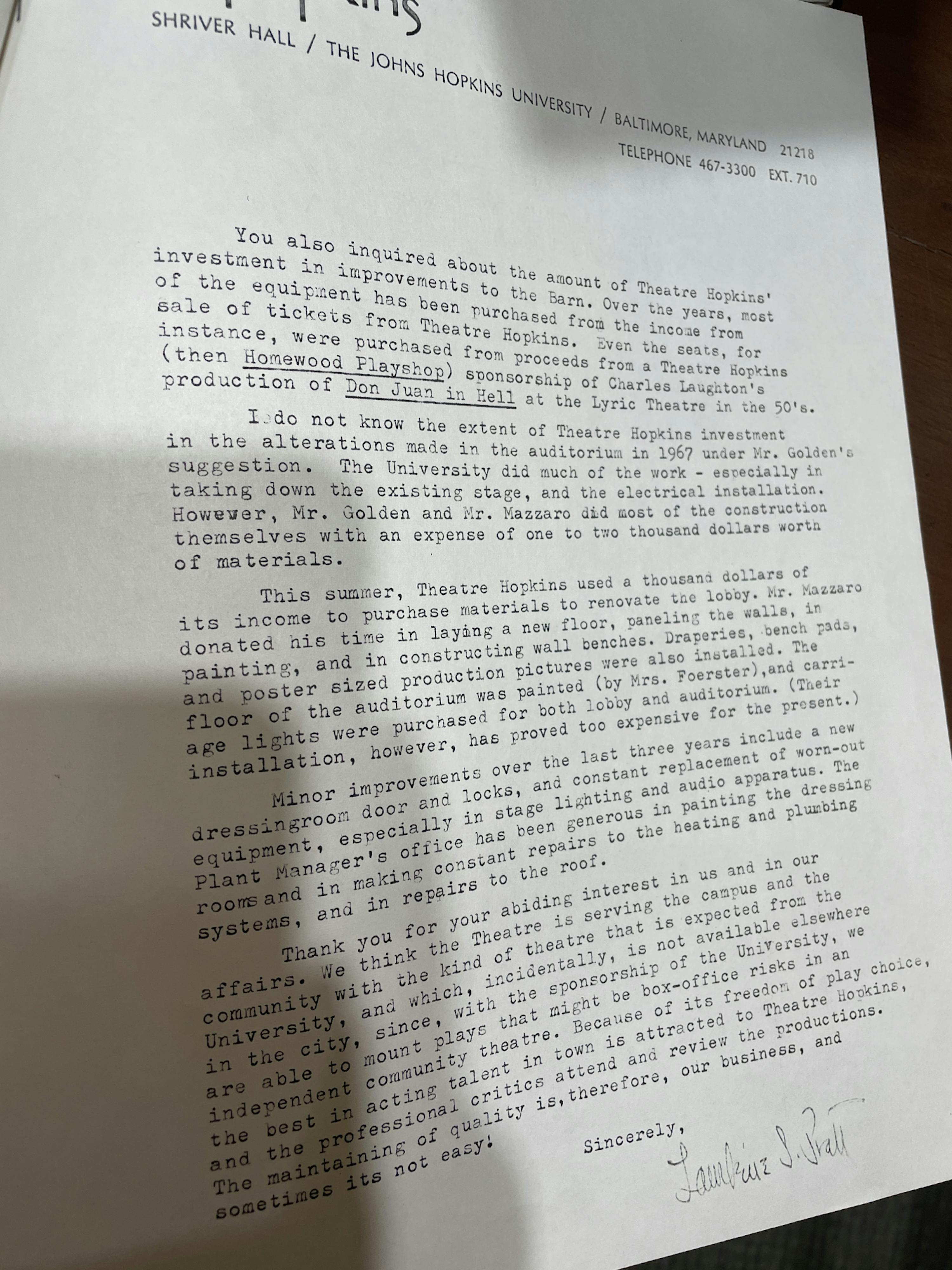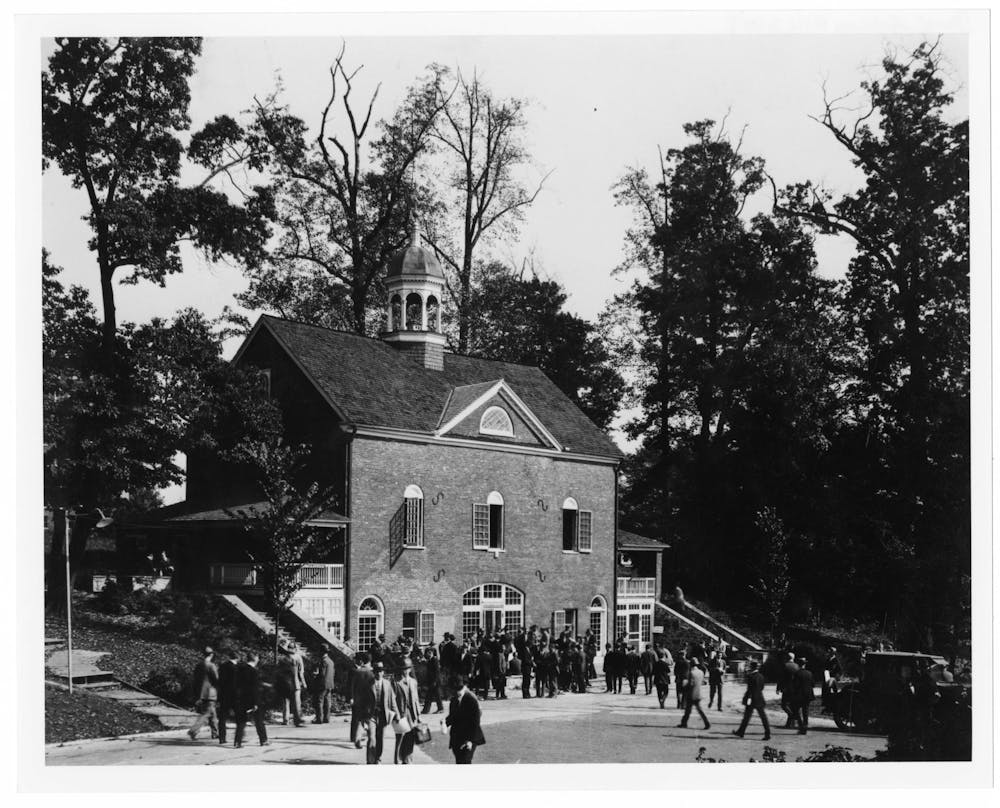Merrick Barn, located behind Brody Learning Commons, is one of the oldest buildings on campus and home to the Undergraduate Program in Theatre Arts and Studies at Hopkins.
According to A Brief History of the Homewood Campus: Its Buildings, Monuments, and Sculpture, the Barn (as it was formerly named) was first constructed in 1803 for Charles Carroll, Jr., son of Charles Carroll of Carrollton — signer of the Declaration of Independence and one of the wealthiest American men at the time. The Barn was part of Carroll’s house, which is now known as the Homewood Museum. The building was initially intended for housing dairy cattle and storing carriages, as reflected in the architectural plan below.

COURTESY OF LANA SWINDLE
When the University moved to Homewood Campus, the Barn was converted into a student center. It was remodeled to accommodate various projects taking place on campus, from theater productions to academic organizations meetings.
The Barn consisted of three floors. The ground floor included three lunchrooms and a barber shop. The second floor contained the office of The News-Letter itself, which moved to the Gatehouse in October 1965, as well as that of the Young Men’s Christian Association, which closed its Homewood Campus branch in 1969. The final floor — the loft — was used as headquarters for the Dramatic Club at Hopkins, later renamed the JHU Barnstormers. The Barn also housed Theatre Hopkins, a community-based troupe affiliated with the University.
The Barn functioned as a student center until the early 1980s. In 1982, the Friends of Homewood Barn, Inc. was formed as a means of renovating the building. Steven Muller and Ross Jones — then president and vice president of the University, respectively — began discussing plans to remodel the Barn in July of that year. As one of the oldest buildings on campus, renovation of the Barn’s facilities was in order.
In January 1983, Robert G. Merrick, Sr., Hopkins alum and president of the Equitable Trust Company in Baltimore, attempted to help the University realize this project. Having established the Robert G. and Anne M. Merrick Foundation in 1962, Merrick provided a grant of $50,000 to the Friends of Homewood Barn, Inc.
According to letters between Ross Jones and affiliates of the Friends of Homewood Barn, Inc., despite Merrick’s donation, funding was still difficult to secure. Fiscal constraints were tight, and the University was initially unable to set aside enough funding for renovation. The Barn required more work than was anticipated, and the University was planning to renovate several academic and research buildings at the same time, which required approximately $4.9 million on their own. They were also obliged to comply with government regulations on asbestos testing, which further prevented Hopkins from securing funding for the Barn’s renovation.
In February 1983, Merrick responded to these constraints with another $100,000 donation. Though he requested that his gift be treated anonymously in a letter to the University, his funding for the building’s renovation resulted in it being rechristened “Merrick Barn.” However, this was not the last of his donations, nor was he the only benefactor to the renovation.
The Jacob and Annita France Foundation, Inc., established by Jacob France, a Baltimore attorney and graduate of the University of Maryland Law School, also contributed to the renovation’s funding.
Over the course of three years, the Merrick and France foundations — which later merged into the France-Merrick Foundation in 1998 — provided $300,000 in total for the remodeling of Merrick Barn. The final donation was provided in January 1985.
After combining these donations with its own funds, the Friends of Homewood Barn found they had secured enough funding to completely renovate the Barn. Following the renovation, the Barn became the headquarters for campus theater organizations and productions and remains so today.

COURTESY OF LANA SWINDLE
Theatre Hopkins particularly benefited from this renovation, which occupied Merrick Barn since its original stage was torn down in the early 1940s. According to the letter above, the group occasionally encountered difficulties with the building as it was constructed in the 19th century.
Prior to the University’s remodeling of the Barn in the 1980s, Theatre Hopkins was fully funding all of the Barn’s improvements. Securing their funding from ticket sales, Theatre Hopkins attempted several smaller upgrades — layering new floors, paneling walls and painting and constructing wall benches, to name a few. The renovation a decade later provided much-needed upgrades for their productions.
Merrick Barn was fully turned over to the undergraduate theater department in 2005, displacing Theatre Hopkins from its home at the University.
Today, Merrick Barn is one of the primary theaters on the Homewood Campus and serves as headquarters for the undergraduate theater department, which, until 2021, was headed by actor and Hopkins alum John Astin. The department is now directed by Abraham Stoll, a dramaturg, author and the former Head of Text and Context at the The Old Globe and University of San Diego Shiley Graduate Acting Program.

COURTESY OF LANA SWINDLE
Despite the numerous renovations to this building over the past century, Merrick Barn still appears in much the same way as it did in 1803. While it is easy to overlook, especially given recent construction around its location, this staple of Homewood Campus is one of the oldest Hopkins buildings still regularly used by students and faculty today.





